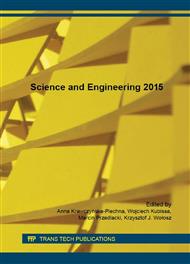p.115
p.125
p.131
p.137
p.145
p.151
p.158
p.166
p.174
Adhesion Assessment between Concrete Layers Using the Ultrasonic Pulse Velocity Method
Abstract:
Adhesion assessment between concrete layers with the use of the non-destructive ultrasonic pulse velocity (UPV) method has been described in the article. Two-layer concrete elements, obtained by drilling the core from a large size multilayer element, were the object of testing. The ultrasonic wave velocity of the element and the materials of which its layers were made were assigned for each element. On that basis, the comparative velocity i.e. the velocity at which an ultrasonic wave going through the boundary surface of layers wouldn’t cause any change in the velocity, was determined. The ratio of the two velocities has been compared to adhesion values obtained through the semi-destructive pull-off method. It was revealed that when the ratio of the ultrasonic wave velocity of the element to comparative velocity increases, the pull-off adhesion value also increases.
Info:
Periodical:
Pages:
145-150
Citation:
Online since:
November 2015
Authors:
Price:
Сopyright:
© 2015 Trans Tech Publications Ltd. All Rights Reserved
Share:
Citation:


